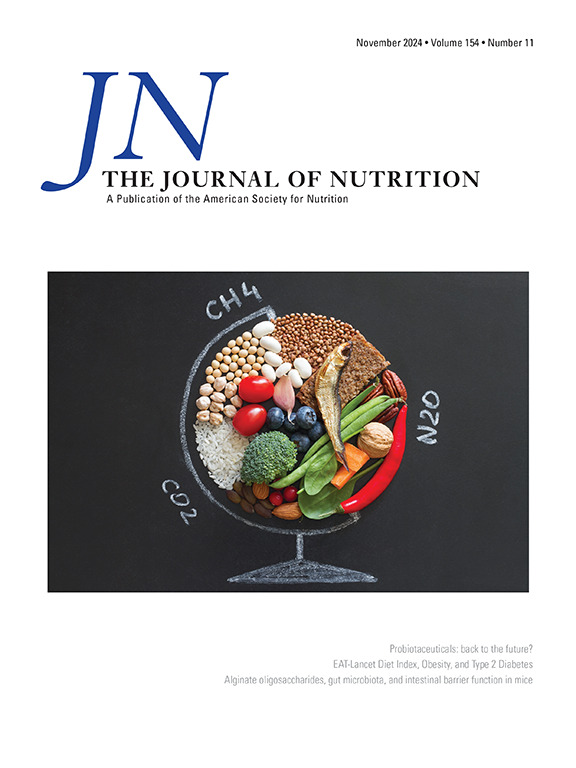家庭营养安全量表(HNSS):进一步建立马萨诸塞州全州样本的效度和信度。
IF 3.8
3区 医学
Q2 NUTRITION & DIETETICS
引用次数: 0
摘要
背景:美国最早用于评估营养安全的调查措施之一被称为家庭营养安全量表(HNSS)。虽然在原HNSS开发研究中进行的分析支持量表的效度和信度,但一些调查开发步骤超出了原研究的范围,如验证性因子分析(Confirmatory Factor Analysis, CFA)和差异项目功能(Differential Item Functioning, DIF)。目的:对马萨诸塞州一个新的全州范围内的HNSS样本进行CFA和DIF分析。方法:从2022年11月至2023年1月,大波士顿食品银行(GBFB)和麻省总医院布里格姆(MGB)对马萨诸塞州成年人进行了全州代表性的横断面调查。除其他主题外,受访者还回答了有关社会人口统计学的问题并完成了HNSS。为了评估CFA模型的拟合,我们计算了Satorra-Bentler尺度卡方检验、近似均方根误差(RMSEA)、标准化均方根残差(SRMR)和Bentler比较拟合指数(CFI)。计算Cronbach’s alpha来评估内部一致性。采用Cochran-Mantel-Haenszel程序调查不同人口统计学组间的DIF。结果:分析样本的参与者(n=2,903)大多数年龄在54岁以下(60.7%),女性(58.0%),非西班牙裔白人(71.3%),家庭收入低于75,000美元(71.1%)。CFA模型拟合指标完全在足够模型拟合的阈值内(卡方5.213 (DF=2, p = 0.074), RMSEA = 0.024 (95% CI = 0.000 - 0.049), SRMR = 0.006, CFI = 0.999)。Cronbach’s alpha为0.923。在年龄、种族/民族、性别、受教育程度、收入、家庭中是否有孩子或家庭规模的人群中,没有迹象表明这四个项目中的任何一个都有DIF。结论:这些发现进一步支持了HNSS的结构效度和信度,并进一步支持了该量表在不同社会人口统计学家庭样本中的研究和项目评估目的。本文章由计算机程序翻译,如有差异,请以英文原文为准。
Household Nutrition Security Scale (HNSS): Further Establishing Validity and Reliability in a Statewide Sample in Massachusetts
Background
One of the first survey measures for assessing nutrition security in the United States is referred to as the Household Nutrition Security Scale (HNSS). Although the analyses conducted in the original HNSS development study supported the validity and reliability of the scale, some survey development steps were beyond the scope of the original study, such as confirmatory factor analysis (CFA) and differential item functioning (DIF).
Objectives
This study aims to conduct CFA and DIF analyses on the HNSS within a new statewide sample in Massachusetts.
Methods
From November 2022 to January 2023, the Greater Boston Food Bank and Mass General Brigham conducted a cross-sectional, statewide, representative survey of Massachusetts adults. In addition to other topics, respondents answered questions about sociodemographics and completed the HNSS. To assess CFA model fit, the Satorra–Bentler scaled chi-squared test, root mean square error of approximation (RMSEA), standardized root mean square residual (SRMR), and the Bentler Comparative Fit Index (CFI) were calculated. Cronbach’s alpha was calculated to assess internal consistency. The Cochran–Mantel–Haenszel procedure was used to investigate DIF across demographic groups.
Results
Participants in the analytic sample (n = 2903) were mostly at or under age 54 (60.7%), women (58.0%), non-Hispanic White (71.3%), and with household incomes <$75,000 (71.1%). CFA model fit metrics were well within thresholds for adequate model fit [chi-square 5.213 (Degrees of freedom (DF) = 2, P = 0.074), RMSEA = 0.024 (95% confidence interval: 0.000, 0.049), SRMR = 0.006, and CFI = 0.999]. Cronbach’s alpha was 0.923. There was no indication of DIF for any of the 4 items across groups for age, race/ethnicity, gender, educational attainment, income, having children in the household, or household size.
Conclusions
These findings further support construct validity and reliability of HNSS, and the further use of the scale for research and program evaluation purposes within sociodemographically diverse samples of households.
求助全文
通过发布文献求助,成功后即可免费获取论文全文。
去求助
来源期刊

Journal of Nutrition
医学-营养学
CiteScore
7.60
自引率
4.80%
发文量
260
审稿时长
39 days
期刊介绍:
The Journal of Nutrition (JN/J Nutr) publishes peer-reviewed original research papers covering all aspects of experimental nutrition in humans and other animal species; special articles such as reviews and biographies of prominent nutrition scientists; and issues, opinions, and commentaries on controversial issues in nutrition. Supplements are frequently published to provide extended discussion of topics of special interest.
 求助内容:
求助内容: 应助结果提醒方式:
应助结果提醒方式:


